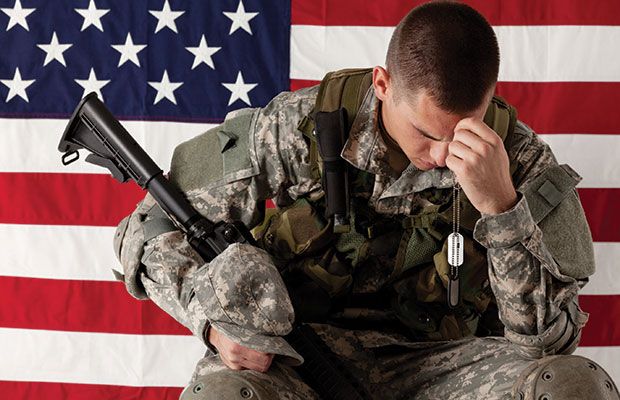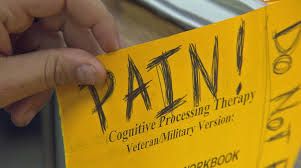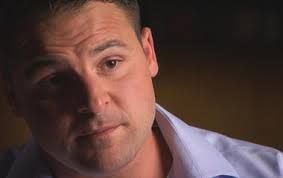Post-Traumatic Stress Disorder
Two New PTSD Treatments Offer Hope for Veterans
Do you—or someone you know—suffer from PTSD? Please read this.
Posted November 26, 2013

Last Sunday, 60 Minutes broadcast a story about two new therapies being used to treat veterans with Post-Traumatic Stress Disorder (PTSD). The treatments are called “Prolonged Exposure Therapy” (PE) and “Cognitive Processing Therapy” (CPT). The new treatments were originally designed for attack and abuse victims.
Two million Americans have served in Iraq and Afghanistan, and 20 percent of them are estimated to have PTSD. The Veterans Health Administration has been overwhelmed with PTSD patients. Now, with the help of these two new therapies thousands of veterans are in the process of getting their lives back.
The 60 Minutes cameras went behind closed doors for a meeting of 16 veterans from Iraq and/or Afghanistan. The veterans candidly share how difficult it has been to return to civilian life. There are also Vietnam vets coping with PTSD participating in the group.
If you have time to watch the 20 minute episode of 60 Minutes titled “The War Within: Treating PTSD” please click here.
Prolonged Exposure Therapy
Prolonged Exposure Therapy forces a patient to vividly remember every detail of a traumatic experience and verbalize the memories. On the 60 minutes program we see a soldier named Collins going through this therapy, as he struggles to recall things he would prefer to forget.
Dr. Kevin Reeder is the man behind the VA program. He explains that the idea is to relive the story of the attack at least five times in a single session, and then listen to your voice on tape re-telling the story. The belief is that hearing the traumatic memory repeatedly will neutralize its power from bubbling up from your subconscious memory and catching you off guard.

Collins says that Prolonged Exposure Therapy is helping him to overcome his survivor’s guilt, which is a building block to him for a next step in life. “Every time I get through it, I get stronger,” he said. “I didn’t want to be alive... My whole purpose of life was gone.”
Another veteran named Gable Darbonne describes how the smell of diesel from any gas station sends him back to being in a war zone. Among other things like crowds, the smell of diesel triggered a tidal wave of memories that led him to avoid gas stations all together and become a recluse.
Reeder said that Prolonged Exposure Therapy is designed to help people see “the impact and the meaning that these stories have on their lives.” He also said that these therapies were originally developed for abuse victims, and the symptoms are often similar for post-war PTSD.
If you have PTSD, with the help of your therapist, you can change how you react to things that trigger traumatic memories. In PE, you work with your therapist to relive the trauma-related situations and verbalize the memories in a safe place and at a comfortable pace.
Usually, you start with things that are less distressing and move towards things that are more distressing. A round of PE therapy most often involves meeting alone with a therapist for about 8 to 15 sessions. Most therapy sessions last 90 minutes.
With time and practice, you will be able to see that you can master stressful situations. The goal is that you can learn to consciously control the ‘explicit’ memories and learn how to harness the ‘implicit’ memories when they surface from your subconscious mind. If you have PTSD, Prolonged Exposure Therapy can help you get your life back after you have been through a trauma.
For more on the neuroscience of chronic anxiety please check out my Psychology Today blog: "The Size and Connectivity of the Amygdala Predicts Anxiety."
Prolonged Exposure (PE) is one exposure therapy that works for many people who have experienced trauma. According to the VA, the three main components of PE are:
- Breathing. Breathing is a skill that helps you relax. When people become anxious or scared, their breathing often changes. Learning how to control your breathing can help in the short-term to manage immediate distress.
- Real world, “In Vivo” exposure. Exposure practice with real-world situations is called “in vivo” exposure. You practice approaching situations that are safe, but which you may have been avoiding because they are related to the trauma. An example would be a veteran who avoids driving since he experienced a roadside bomb while deployed. In the same way, a sexual trauma survivor may avoid getting close to others. This type of exposure practice helps your trauma-related distress to lessen over time. When distress goes down, you can gain more control over your life.
- Talking through the trauma and replaying the tape. Talking about your trauma memory over and over with your therapist is called "imaginal exposure." Talking through the trauma will help you get more control of your thoughts and feelings about the trauma. You will learn that you do not have to be afraid of your memories. This may be hard at first and it might seem strange to think about stressful things on purpose. Many people feel better over time, though, as they do imaginal exposure. Talking through the trauma helps you make sense of what happened and have fewer negative thoughts about the trauma.
Cognitive Processing Therapy

The VA is offering a second experimental therapy called Cognitive Processing Therapy (CPT). Dr. Reeder said that repeated trauma can leave veterans feeling like the world at large is a dangerous place. This therapy method begins with writing an impact statement, which is shared with the group in which veterans talk about “how their lives are still held in the grip of war.”
The participants work through scenarios to examine their guilt and other negative emotions, to help people put wartime wounds in the past and figure out what their futures hold. Many in the group said they would go back into combat if they had the opportunity, in part because of the camaraderie. In the CPT groups, veterans seem to bond and recreate this sense of camaraderie with other soldiers in a safe environment.
Trauma causes most people to struggle with their memories and nightmarish flashbacks of the event. If you suffer from PTSD you may have a hard time making sense of what happened. You may find yourself getting "stuck" and ruminating in your thoughts about the trauma and how it continues to affect your life.

Through CPT you can begin to consciously make sense of the trauma and ‘face the dragon head on’ instead of trying to avoid thinking about or dealing with your memories. CPT makes it easier to cope with traumatic events and get back to living your life to its fullest.
By using the skills learned in this Cognitive Processing Therapy, you can learn why recovery from traumatic events has been hard for you. CPT helps you learn how going through a trauma changed the way you look at the world, yourself, and others. The way we think and look at things directly affects how we feel and act.
According to the VA, there are four components to CPT:
- Learning About Your PTSD Symptoms. CPT begins with education about your specific PTSD symptoms and how the treatment can help. The therapy plan will be reviewed and the reasons for each part of the therapy will be explained. You will be able to ask questions and to know exactly what you are going to be doing in this therapy. You will also learn why these skills may help.
- Becoming Aware of Thoughts and Feelings. Next, CPT focuses on helping you become more aware of your thoughts and feelings. When bad things happen, we want to make sense of why they happened. An example would be a Veteran who thinks to himself or herself, "I should have known that this would happen." Sometimes we get stuck on these thoughts. In CPT you will learn how to pay attention to your thoughts about the trauma and how they make you feel. You'll then be asked to step back and think about how your trauma is affecting you now. This will help you think about your trauma in a different way than you did before. It can be done either by writing or by talking to your therapist about it.
- Learning Skills. After you become more aware of your thoughts and feelings, you will learn skills to help you question or challenge your thoughts. You will do this with the help of worksheets. You will be able to use these skills to decide the way you want to think and feel about your trauma. These skills can also help you deal with other problems in your day-to-day life.
- Understanding Changes in Beliefs. Finally, you will learn about the common changes in beliefs that occur after going through trauma. Many people have problems understanding how to live in the world after trauma. Your beliefs about safety, trust, control, self-esteem, other people, and relationships can change after trauma. In CPT you will get to talk about your beliefs in these different areas. You will learn to find a better balance between the beliefs you had before and after your trauma.
During your therapy you will also have the chance to practice your new skills outside of your therapy meetings.You and your therapist will work together to help you learn a new way of dealing with the pain your trauma. In CPT you will work closely with your therapist to reach your goals. You will be meeting with him or her on a regular basis for 12 sessions.
The more you practice your new skills, the sooner they will begin working for you. By choosing to approach your experiences in a new and different way, you will be able to decide how your past affects your future.
Conclusion: If you have PTSD, “Don’t Judge it.” Reach out and ask for help.

Gable Darbonne graduated from high school in 2001. 9/11 convinced him to sign up with an Army recruiter. He volunteered and was willing to give his life for his country. His service in Afghanistan and Iraq included a house explosion in which two of his friends were burned. Darbonne admitted that he took some of his emotions out on Iraqi locals in the wake of these incidents. He talks about how war changed him as a person on the 60 Minutes program, and how his survival instinct came into play.
Gable Darbonne also said that he was reclusive and sometimes would not leave the house for days. He lived nine years of his life afraid to even make small talk. But eventually he listened to coworkers, who urged him to get help from the VA.
His advice to the friends and family of veterans is to just listen to what they have to say. “Don’t judge it,” he advised. What about those veterans who are hearing this story and struggling with their own demons? “I hope you find the courage to get help, because all you’re doing is killing yourself,”
Another veteran, Collins, said on the 60 Minutes program, although it was hard for him to get help, he is now glad that he went through with it. Across the United States, 77% of vets who go through the program will see a decrease in PTSD symptoms. Though it’s a start, it is not a cure, and even Dr. Reeder admits that. “We have to teach people that they can live with this and live a valued life, a life they want,” he concludes.
If you, or someone you know, is a veteran suffering from PTSD please talk to your VA healthcare provider about getting Prolonged Exposure and/or Cognitive Processing Therapy. A list of Veterans Affairs facilities can be found online at: VA Facilities Locator.
All VA Medical Centers offer PTSD treatment, even if there is no specific PTSD program. Contact your local VA Medical Center and ask for the Mental Health clinic.
The Veterans Crisis Line:
The Veterans Crisis Line provides support for veterans and their loved ones 24/7. For immediate assistance, call 1–800–273–8255, Press 1.
You can also text message 838255 to get live help 24 hours a day, 7 days a week, 365 days of the year. The Veterans Crisis Line text-messaging service does not charge for texting.
Or try Confidential Veterans Chat to Instant Message (IM) online with a counselor 24/7, 365 days of the year.
These services are free and confidential for veterans and their loved ones—even if a veteran is not registered with VA or enrolled in VA health care. Responders will work with you to get through any personal crisis.
For anyone needing PTSD help please visit: Where to Get Help for PTSD
For other VA help please visit: Get Help with VA PTSD Care, Benefits, or Claims
Email the VA about PTSD at: ncptsd@va.gov
Also see: VA Mental Health




